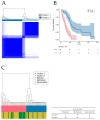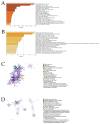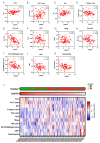CHST4 Gene as a Potential Predictor of Clinical Outcome in Malignant Pleural Mesothelioma
- PMID: 38396947
- PMCID: PMC10889779
- DOI: 10.3390/ijms25042270
CHST4 Gene as a Potential Predictor of Clinical Outcome in Malignant Pleural Mesothelioma
Abstract
Malignant pleural mesothelioma (MPM) develops primarily from asbestos exposures and has a poor prognosis. In this study, The Cancer Genome Atlas was used to perform a comprehensive survival analysis, which identified the CHST4 gene as a potential predictor of favorable overall survival for patients with MPM. An enrichment analysis of favorable prognostic genes, including CHST4, showed immune-related ontological terms, whereas an analysis of unfavorable prognostic genes indicated cell-cycle-related terms. CHST4 mRNA expression in MPM was significantly correlated with Bindea immune-gene signatures. To validate the relationship between CHST4 expression and prognosis, we performed an immunohistochemical analysis of CHST4 protein expression in 23 surgical specimens from surgically treated patients with MPM who achieved macroscopic complete resection. The score calculated from the proportion and intensity staining was used to compare the intensity of CHST4 gene expression, which showed that CHST4 expression was stronger in patients with a better postoperative prognosis. The median overall postoperative survival was 107.8 months in the high-expression-score group and 38.0 months in the low-score group (p = 0.044, log-rank test). Survival after recurrence was also significantly improved by CHST4 expression. These results suggest that CHST4 is useful as a prognostic biomarker in MPM.
Keywords: CHST4; FFPE; immunohistochemistry; malignant pleural mesothelioma; prognostic factor.
Conflict of interest statement
The funders had no role in the design of the study; in the collection, analyses, or interpretation of data; in the writing of the manuscript; or in the decision to publish the results.
Figures






Similar articles
-
LAG3 is an independent prognostic biomarker and potential target for immune checkpoint inhibitors in malignant pleural mesothelioma: a retrospective study.BMC Cancer. 2023 Dec 7;23(1):1206. doi: 10.1186/s12885-023-11636-1. BMC Cancer. 2023. PMID: 38062416 Free PMC article.
-
KIAA0101 in Malignant Pleural Mesothelioma: A Potential Diagnostic and Prognostic Marker.Comb Chem High Throughput Screen. 2022;25(9):1498-1506. doi: 10.2174/1386207324666210707105634. Comb Chem High Throughput Screen. 2022. PMID: 34238152
-
MicroRNA-98 is a prognostic factor for asbestos-induced mesothelioma.J Toxicol Environ Health A. 2020 Feb 1;83(3):126-134. doi: 10.1080/15287394.2020.1734891. Epub 2020 Mar 2. J Toxicol Environ Health A. 2020. PMID: 32114955
-
Genomics and Functional Genomics of Malignant Pleural Mesothelioma.Int J Mol Sci. 2020 Sep 1;21(17):6342. doi: 10.3390/ijms21176342. Int J Mol Sci. 2020. PMID: 32882916 Free PMC article. Review.
-
Mesothelioma Biomarkers: Discovery in Search of Validation.Thorac Surg Clin. 2020 Nov;30(4):395-423. doi: 10.1016/j.thorsurg.2020.08.001. Epub 2020 Sep 14. Thorac Surg Clin. 2020. PMID: 33012429 Review.
Cited by
-
Molecular Mechanisms of Tumor Progression and Novel Therapeutic and Diagnostic Strategies in Mesothelioma.Int J Mol Sci. 2025 May 1;26(9):4299. doi: 10.3390/ijms26094299. Int J Mol Sci. 2025. PMID: 40362535 Free PMC article. Review.
References
MeSH terms
Substances
LinkOut - more resources
Full Text Sources
Medical

